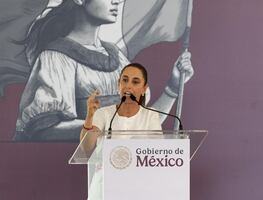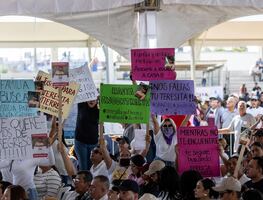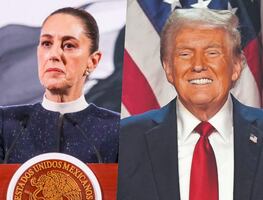Más Información

Sheinbaum asegura apoyo total a Sinaloa para enfrentar violencia; "Nunca los vamos a dejar solos, aquí está la presidenta"

Dictan 600 años de prisión a "El Negro" Radilla y "El Cone"; responsables de secuestrar al hijo de Javier Sicilia

Familias de desaparecidos en Mazatlán irrumpen en evento de Sheinbaum; mandataria promete atender peticiones

Sheinbaum responde a Trump sobre declarar a cárteles como organizaciones terroristas; rechaza injerencia extranjera

PAN exige renuncia de Rubén Rocha Moya; Claudia Sheinbaum sigue protegiéndolo en “complicidad vergonzante”
For the first time in its history, Mexico declared war on May 28, 1942 . The enemy was the Axis powers comprised of Germany , Italy , and Japan , during World War II . The reason behind it was the sinking of two Mexican oil tankers by German torpedoes: Potrero del Llano and Faja de Oro, that supplied the U.S., on May 13 , and 20 .
The then-President Manuel Ávila Camach o said on a speech that he was going to fulfill "the most serious of duties that lay on the State: the one of submitting the national representation to the need to resort to a country's last resource… No consideration stopped the aggressors . Neither the neutrality of the country to which the vessels belonged nor that they displayed all the external signs of their nationality ,” neither the human condition of those on board.

It was until May 8, 1944 , when the Mexican government publicly announced that national soldiers would be taken to different battlefronts by mid-July.
Mexico would join the United States with an expeditionary unit that would help the Allies in the Philippines performing inspection overflights to track the enemy so that the Americans could venture into the jungle and defeat the Japanese .
The Mexican Expeditionary Air Force (FAEM) , best known as Fighter Squadron 201 , was made up of at least 300 men at the service of the Army with seniority and experience as well as of young men recently graduated from military schools and 62 volunteer civilians who came from the War Supplies Factory . Later on, on the battlefront, they became known as the Aztec Eagles .
At the beginning of WWII , the Philippines was not an independent country. “We were still of North American colony, although we had an autonomous government, the U.S. controlled the foreign policy and the policies for the defense of the islands,” said the Philippines Ambassador in Mexico José A. de Vega to EL UNIVERSAL .
Recommended: The German attack that plunged Mexico into WWII
The book Escuadrón 201. México en la Segunda Guerra Mundial (Fighter Squadron 201. Mexico on Wolrd War II), tells that once they were selected, the members of the squadron “were bid farewell with flowers, hugs, and words of encouragement both from their families and from an elated crowd” on July 24, 1944 , in the Buenavista train station; they were bound to the U.S. There, they were trained in air bases in Texas to then leave for the battlefront to join group 58 of the U.S. Air Force , in charge of General Douglas MacArthur in the Pacific.
The initially left for Nuevo Laredo, Tamaulipas , to arrive in Texas, where they were received by civil authorities from that American city and by a military band from that nation that interpreted Mexican composer Genaro Codina’s “La marcha de Zacatecas,” which the Americans thought was Mexico’s national anthem,
After several months of training in Texas, they completed their training in February 1945 . At least two of them died during this stage; those who graduated did so with merit .
The arrival in Manila, the Philippines
It was April 1945 when the Fighter Squadron 201 finally arrived in the Philippines with the objective of fighting the Japanese troops . In the town of Porac , during the arrival ceremony at 6 am, the Mexican flag flew for the first time ever in another country during the war . In that country, the members of this military unit were welcomed with excitement and people even brought them flowers.
“There was our country, its history, and the honor of a whole nation represented by an Army that would contribute to the liberation of a brother nation and to defeat of one of the Axis powers in order to restore global peace ; ideals for which we were willing to give our lives for if required,” said Deputy Sergeant Fernando Nava Musa in the book.
Recommended: Temixco, a former WWI concentration camp for the Japanese in Mexico
Since then, and due to the work of Nava Musa, our flag must be flown at half-mast by government decree every May 2 as a tribute and commemoration of the participation of the Fighter Squadron 201 on WII.
Ambassador José A. de Vega says that in Porac “the elderly still remember the Mexicans who went there.”

Eduardo José A. de Vega remembers that in one of the meetings he attended with some members of the Fighter Squadron 201 , “one of the veterans mentioned that when they were called they thought, ‘Why am I going to fight against Japan if they did nothing to me? But President Ávila Camacho’s words were very inspiring, who said it was a commitment Mexico should perform.”

“The public, the neighborhoods, welcomed them with flowers because the Filipinos were already under the control of the Japanese , but we knew that would change because the Americans had already controlled Manila and little by little they would get rid of the Japanese, that’s why they were well-received,” added ambassador De Vega.

In addition to sighting the enemy’s positions, their mission consisted of “the destruction of military posts and of supporting the operations of the Allies troops fighting on land,” according to the book, in order to achieve the liberation of the Philippines. Their area of action was Porac , a town in the Pampanga province in the north of the Philippines.
According to the archives of the National Institute of Historic Studies on Mexico’s Revolutions (INEHRM) , the Fighter Squadron 201 performed 96 missions along with the Allies in WWII, it launched 252 general-purpose bombs , and flew 1,966 hours in combat zones.
The Mexicans participated in WWII during only seven months from the six years it lasted, however, it was an important help for the Philippines, as mentioned by the consul, “they certainly saved many lives.”

Pancho Pistolas as their emblem
Lieutenant Miguel Moreno Arreola
, who was a member of the Fighter Squadron 201, was who chose “ Panchito ,” dubbed Pancho Pistolas in Spanish, the animated character from Disney’s The Three Caballeros film , as the representation of the Mexican, Latin American, and U.S. unity at the Battle of Luzon .
De Vega says that there were many children at his country that had seen the movie so they related the members of the Fighter Squadron 201 with Pancho Pistolas .
This character was a Mexican rooster , a friend of Donald Duck, who along with José , gave life to The Three Caballeros. The film premiered in 1944 with the objective of obtaining the political support of Latin American countries to the U.S. in the war.
As a good Mexican, Panchito was very joyful and liked to sing in Mexican traditional parties wearing a charro sombrero and carrying a pair of guns on his hips to shoot whenever he wanted.

The return to Mexico
The Fighter Squadron 201 returned to Mexico after the Japanese army surrendered on September 2, 1945 . Former-president Ávila Camacho welcomed them with all the honors for war heroes ; they also received recognition from the U.S. Air Force and from the Philipines .
The members of the Squadron were promoted to the immediate superior military rank and were granted the Medal for Service in the Far East , Mexico’s Legion of Honour Medal , the Medal for the Liberation of the Republic of the Philippines , with a badge for the presidential recommendation, and some U.S. decorations including the Air Efficiency Award , the American Campaign Medal , the Asia-Pacific Campaign Medal , and the World War II Victory Medal .

Ambassador De Vega said that even “the American General Douglas MacArthur praised them because they had very relevant participation. No one would say we wouldn’t have won without the Mexicans, but they were really helpful because their missions saved lives .”
On the morning of Sunday, November 18, 1945 , the Aztec Eagles were awaited in Mexico City by hundreds of men, women, and children who gathered at the Buenavista train station. EL UNIVERSAL documented that joyful day:
Recommended: Doodle to commemorate Mexican "Schindler"
“The heroes arrived filling the city with applause… 300 young men came back from the tragic war theater where Mexican blood was shed as a symbol of their fulfilled destiny. They were already here, calming the anxiousness of their close ones and some could even, in a rush and full of emotions, hug their loved ones upon their arrival, because they had to receive the people’s applause and warm hug, the hoorays of all Mexicans , who knew how to fill with flowers and love the whole journey of the eagles from the station to the National Palace.”
EL UNIVERSAL reported on its front page all the details on the arrival of the national heroes . The first one to descend from the train was General Antonio Cárdenas Rodríguez , who, after following the military protocol , took to the microphone to thank all the attendees and the whole country: “Dear Mexican people – he began with a voice that could not conceal his emotion – in behalf of all the chiefs, officials and the Expeditionary Troop under my charge, I give you our best and most emotional greeting and I thank you for the sympathy and love you have shown us today.”
“Filling the air with confetti, streamers, and messages, the people greeted our heroes , the members of the Expeditionary Air Force, during their journey on board of their own jeeps from the Central Station to the Zócalo,” according to the written chronicles.

Memories from the Squadron in the city
According to author Rolando Niquet , “it’s thought that the participation of the FAEM during the liberation of the Philipines archipelago cause over 30,000 casualties among the Japanese troops.”
In 2012, the Fighter Squadron 201 received the highest military decoration granted by the Philipines government, the Legion of Honor of the Philipines, from the then-President Gloria Macapagal-Arroyo .
“Because we know they were heroes and her, as president, was interested in strengthening the Filipino ties with Mexico , Latin America , and Spain ,” added the Philippines consul in Mexico.



Other of the homages carried out to keep the memories from this unit alive is on the Chapultepec Park at the Mausoleum of the Mexican Expeditionary Air Force that is home to the mortal remains of five pilots who were killed in action: Captain Pablo Ruiz Rivas Martínez , Lieutenant José Espinoza Fuentes , Lieutenant Héctor Espinoza Galván , Second Lieutenant Fausto Vega Santander , and Second Lieutenant Mario López Portillo .

Moreover, the Iztapalapa borough holds three elements that honor the memory of the event: the Monument to the Fighter Squadron 201 , the subway station Escuadrón 201 , and the neighborhood named after the military unit.


Friendly ties between Mexico and the Philipines
A year after the war, in 1946 , Mexico and the Philipines strengthened their bond by starting communications . “For the Philipines, it was an honor that Mexico decided to participate there, in our part of Earth,” said ambassador De Vega.
Mexico
and the Philipines have a monument in honor of the squadron that consists of an eagle eating a snake with the legend “The components of the Mexican Expeditionary Air Force, Fighter Squadron 201, dedicate this monument to the brothers who fell fulfilling their duty.”
According to the ambassador, this monument, built by the soldiers themselves in 1945 , shows the respect and admiration the Philipines has toward Mexico.
Recommended: INAH archeologists discover WWI submarine in Mexican coasts
mp





